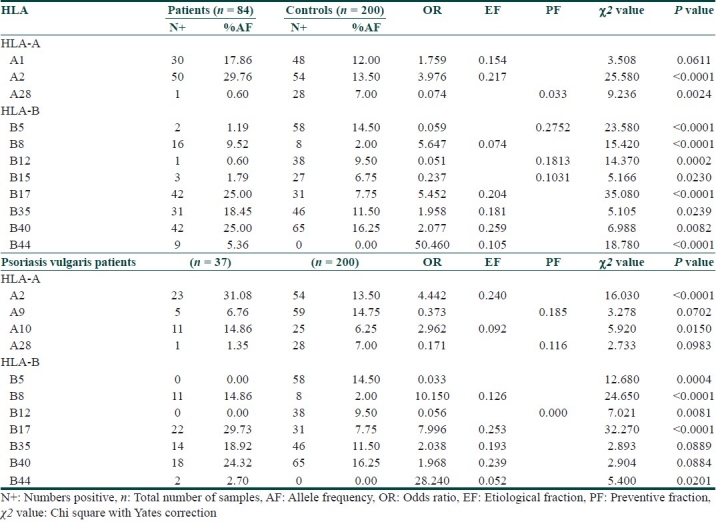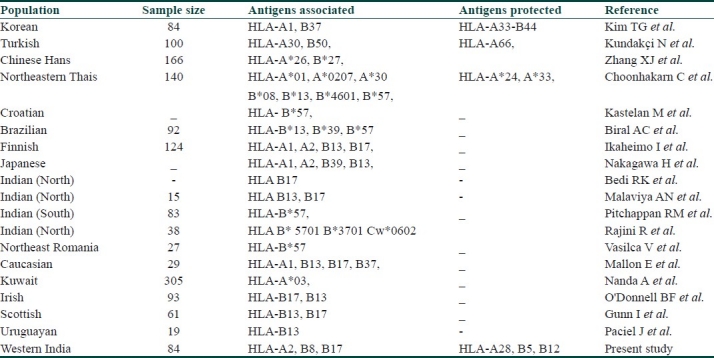Abstract
Background:
Psoriasis, a common autoimmune disorder characterized by T cell-mediated keratinocyte hyperproliferation, is known to be associated with the presence of certain specific Human Leukocyte Antigen (HLA) alleles.
Aim:
To evaluate distribution of HLA-A and HLA-B alleles and hence identify the susceptible allele of psoriasis from patients in Western India.
Materials and Methods:
The study design included 84 psoriasis patients and 291 normal individuals as controls from same geographical region. HLA-A and HLA-B typing was done using Serology typing. Standard statistical analysis was followed to identify the odds ratio (OR), allele frequencies, and significant P value using Graphpad software.
Results:
The study revealed significant increase in frequencies of HLA-A2 (OR-3.976, P<0.0001), B8 (OR-5.647, P<0.0001), B17 (OR-5.452, P<0.0001), and B44 (OR-50.460, P<0.0001), when compared with controls. Furthermore, the frequencies of HLA-A28 (OR-0.074, P=0.0024), B5 (OR-0.059, P<0.0001), B12 (OR-0.051, P=0.0002), and B15 (OR-0.237, P=0.0230) were significantly decreased in psoriasis patients.
Conclusion:
This study shows the strong association of HLA-A2, B8, and B17 antigens with psoriasis conferring susceptibility to psoriasis patients from Western India, while the antigens HLA-A28, B5, and B12 show strong negative association with the disease.
Keywords: HLA antigens, Mumbai, psoriasis, Western India
Introduction
Psoriasis is a chronic inflammatory skin disorder characterized by red, scaly plaques that features the characteristic pathological changes, namely, T cell-mediated keratinocyte hyperproliferation, loss of differentiation and impressive hyperplasia of the epidermis with poorly adherent stratum corneum, and accumulation in the skin of neutrophils and T lymphocytes . Distribution of psoriasis in the world population varies according to ethnic groups and geographical locations, with a peak prevalence of approximately 2% of the population. The disease has a strong but complex genetic background with a concordance of approximately 60% in monozygotic twins.[1] However, the manner in which psoriasis susceptibility genes contribute to pathogenesis is still not clear. One of the most compelling susceptibility factors for psoriasis lies in the major histocompatibilty complex (MHC) region of chromosome 6 which code for Human Leukocyte Antigens (HLA) of a person.
The association of psoriasis and HLA has long been reported on population and family studies. Psoriasis has been reported to be significantly associated with HLA-HLA-A*01, A*02, B13, B17, B39, B57, Cw*06, Cw*07, and DR7, DQA1*0201.[2–9] This relationship, however, tends to vary between patients of different racial and ethnic backgrounds. Studies from India have revealed the associations of HLA-B*57, DR*07 and HLA-Cw*0602 in psoriasis patients.[3,4] The present study of this population was undertaken to evaluate distribution of HLA-A and B antigens susceptible for psoriasis from patients in this geographical region.
Materials and Methods
The study design included 84 psoriasis patients (59 males and 25 females) and 291 normal individuals as controls from Mumbai. The samples of psoriasis patients were collected from the Skin OPD of K.E.M. Hospital, Parel, Mumbai. The patients were treated with chemotherapy and did not show signs of psoriatic arthritis. The ages of the patients ranged from 18 to 82 years with mean age of 44 years. Unrelated individuals of matched age groups and from same geographical area with no previous history of psoriasis were included as controls. For the 84 patients, HLA-A and HLA-B typing was done using Serology typing. For HLA-A, B serological typing, 10 to 15 ml of venous blood (in heparin 50 IU/ml) was collected from each individual in a sterile tube. Lymphocytes were isolated by density gradient centrifugation on Histopaque. HLA typing was done by the National Institute of Health microlymphocytotoxicity assay using a minimum of three monospecific sera to define a serologic specificity.[10] The antigen frequencies were estimated from the number of positive typing reactions divided by the total number of haplotypes tested (number of individuals studied X 2). Phenotype frequencies, odds ratio (OR), probability value, Chi square with Yates correction, and etiological and preventive fraction were estimated using Graphpad software.[11]
Results
Some significant findings can be concluded from this study. The distribution of HLA-A and HLA-B among the total 84 patients and controls showed a significant increase in frequencies of HLA-A2 (OR-3.976, P<0.0001), B8 (OR-5.647, P<0.0001), B17 (OR-5.452, P<0.0001), and B44 (OR-50.460, P<0.0001), while the frequencies of HLA-A28 (OR-0.074, P=0.0024), B5 (OR-0.059 P<0.0001), B12 (OR-0.051, P=0.0002), and B15 (OR-0.237, P=0.0230) were significantly decreased in psoriasis patients. Furthermore, the frequencies of HLA Class I antigens among patients of psoriasis vulgaris (n = 37) patients revealed that the frequencies of HLA-A2 (OR-4.442, P<0.0001), A10 (OR-2.962, P=0.0150), B8 (OR-10.150, P<0.0001), and B17 (OR-7.996, P<0.0001) were significantly increased as compared with patients, while a significant decrease was seen in frequencies HLA-B5 (OR-0.033, P=0.0004) and B12 (OR-0.056, P=0.0081) as presented in Table 1.
Table 1.
HLA-A and HLA-B antigen distribution in total psoriasis patients

Discussion
This study shows the strong association of HLA-A2, B8, and B17 antigens, with the disease conferring to its susceptibility. The alleles HLA-A28, B5, and B12 show strong negative association with the disease, which are in accordance with a few studies in psoriasis patients among different ethnic populations of the world, as seen from the Table 2.
Table 2.
HLA-A and -B antigens in psoriasis patients amongst different ethnic populations

There is a good correlation between psoriasis and HLA-HLA B13, HLA B17, HLA B37, HLA B39, and Cw6; further, the HLA B38, HLA B39, HLA B27, HLA B17, and Cw6 are associated with psoriatic arthritis. Interestingly, psoriasis is the only chronic inflammatory disease that has a strong association with HLA-C, and about two-thirds of the patients carry the HLA-Cw*0602 allele compared with 10 to 15% in the population at large. In the present study, HLA-Cw*0202 (OR-6.508, P<0.0001) and Cw*0604 (OR-17.710, P=0.0153) were strongly associated with psoriasis. Recent linkage and high-resolution association studies strongly indicate that the specific allele HLA-Cw*0602 is a major susceptibility risk allele for psoriasis.[12] Patients carrying this allele have been shown to have distinct clinical features including an earlier age of disease onset.[12,13] Furthermore, individuals who are homozygous for the HLA-Cw*0602 allele have about 2.5 times higher disease risk than heterozygotes.[14] Although chronic plaque psoriasis is likely to be somewhat heterogeneous with respect to genetic and pathogenic components, available evidence indicates a final common pathogenic pathway involving specific antigen recognition by T cells that results in stimulation of keratinocyte proliferation.[15] And that the cross primed CD8+ T cells respond to antigens in the HLA-Cw*0602 binding pocket of keratinocytes and thereby act as main effector cells in maintaining the pathogenic process.[16] HLA-Cw*0602 is found to be associated among Caucasian patients with guttate psoriasis.[17] HLA serological studies on Indian patients with psoriasis showed association with A1, B17, and Cw06,[18] showing accordance with our findings in reference to the HLA-B and HLA-C loci. From North India, the results showed that Cw*0602 was the main allele that was increased in this group of patients. Cw*0602 was found in 71% of the patients. B*5701 and B*3701 were also increased but appeared to be secondary to linkage disequilibrium with Cw*0602.[3] Eighty-three south Indian patients with psoriasis vulgaris were studied for HLA antigen frequencies and compared with 77 controls and found HLA Bw57 and DR7 association with the disease.[4]
It has been shown that HLA-Cw*06 and Cw*07 have a unique antigen-binding pocket containing both alanine at position 73 (Ala-73) and a negatively charged aspartic acid at position 9 (Asp-9). These residues are most probably important in determining the conformation of the C pocket and in turn the nature of the peptide bound to it. A study on Israeli Jewish psoriatic patients clearly showed that alanine in position 73 is significantly associated with psoriasis vulgaris in Jewish patients.[19] A similar study from Saudi Arabia was done in which sequence-specific primers were used to specifically detect nucleotide coding for Ala-73 and Asp-9 in all the subjects. The results showed significantly higher frequency of Asp-9 (84.0% vs 61.3%) in patients as compared with controls (P<0.05).[20] Hence, studies involving the HLA Cw alleles among our psoriasis patients will enlighten the alleles associated in Western India.
Footnotes
Source of Support: Nil
Conflict of Interest: Nil.
References
- 1.Krueger JG, Bowcock A. Psoriasis pathophysiology: current concepts of pathogenesis. Ann Rheum Dis. 2005;64(Suppl II):ii30–6. doi: 10.1136/ard.2004.031120. [DOI] [PMC free article] [PubMed] [Google Scholar]
- 2.Kim TG, Lee HJ, Youn JI, Kim TY, Han H. The association of psoriasis with human leukocyte antigens in Korean population and the influence of age of onset and sex. J Invest Dermatol. 2000;114:309–13. doi: 10.1046/j.1523-1747.2000.00863.x. [DOI] [PubMed] [Google Scholar]
- 3.Rani R, Narayan R, Fernandez-Vina MA, Stastny P. Role of HLA-B and C alleles in development of psoriasis in patients from North India. Tissue Antigens. 1998;51:618–22. doi: 10.1111/j.1399-0039.1998.tb03004.x. [DOI] [PubMed] [Google Scholar]
- 4.Pitchappan RM, Koteeswaran A, Kakkaniah VN, Manickasundari M, Rajaram V, Muthuveeralakshmi P, et al. HLA Bw57 and DR7 association with psoriasis vulgaris in south India. Tissue Antigens. 1989;34:133–7. doi: 10.1111/j.1399-0039.1989.tb01726.x. [DOI] [PubMed] [Google Scholar]
- 5.Ikaheimo I, Silvennoinen-Kassinen S, Karvonen J, Jarvinen T, Tiilikainen A. Immunogenetic profile of psoriasis vulgaris: Association with haplotypes A2, B13, Cw6, DR7, DQA1FNx010201 and A1, B17, Cw6, DR7, DQA*0201. Arch Dermatol Res. 1996;288:63–7. doi: 10.1007/BF02505045. [DOI] [PubMed] [Google Scholar]
- 6.Nakagawa H, Tokunaga K, Dewald G, Omoto K, Ishibashi Y, Matsuki K, et al. Genetic variants of the complement components and HLA-antigens associated in patients with psoriasis vulgaris in Japanese. Nippon Hifuka Gakkai Zasshi. 1989;99:77–81. [PubMed] [Google Scholar]
- 7.Gonzaga HF, Torres EA, Alchorne MM, Gerbase-Delima M. Both psoriasis and benign migratory glossitis are associated with HLA-Cw06 Association of HLA-A1, B13, B17, B37, Cw06, Cw07, DR7 have been described amongst Caucasian psoriasis patients. Br J Dermatol. 1996;135:368–70. [PubMed] [Google Scholar]
- 8.Bedi TK, Sengupta S, Snehal S, Kaur S, Aikat BK. Histocompatibility antigens in psoriasis. Indian J Dermatol Vernerol Leprol. 1979;45:21–3. [PubMed] [Google Scholar]
- 9.Malaviya AN, Dasgupta B, Tiwari SC, Khan KM, Pasricha JS, Mehra NK. Psoriatic arthritis: A clinical and immunological study in 15 cases from India. J Assoc Physicians India. 1984;32:403–5. [PubMed] [Google Scholar]
- 10.Terasaki PI, McClelland JD. Microdroplet assay of human serum cytotoxins. Nature. 1964;204:998. doi: 10.1038/204998b0. [DOI] [PubMed] [Google Scholar]
- 11.Shankarkumar U, Ghosh K, Badakere S, Mohanty D. Novel HLA Class I alleles associated in Indian leprosy patients. J Biomed Biotech. 2003b;3:208–11. doi: 10.1155/S1110724303210019. [DOI] [PMC free article] [PubMed] [Google Scholar]
- 12.Gudjonsson JE, Karason A, Antonsdottir A, Runarsdottir EH, Hauksson VB, Upmanyu R, et al. Psoriasis patients who are homozygous for the HLA-Cw*0602 allele have a 2.5 fold increased risk of developing psoriasis compared with Cw6 heterozygotes. Br J Dermatol. 2003;148:233–5. doi: 10.1046/j.1365-2133.2003.05115.x. [DOI] [PubMed] [Google Scholar]
- 13.Enerback C, Martinsson T, Inerot A, Wahlström J, Enlund F, Yhr M, et al. Evidence that HLA-Cw6 determines early onset of psoriasis, obtained using sequence-specific primers (PCR-SSP) Acta Derm Venereol. 1997;77:273–6. doi: 10.2340/0001555577273276. [DOI] [PubMed] [Google Scholar]
- 14.Gudjonsson JE, Karason A, Antonsdottir AA, Rúnarsdóttir EH, Gulcher JR, Stefánsson K, et al. HLA-Cw6-positive and HLA-Cw6-negative patients with psoriasis vulgaris have distinct clinical features. J Invest Dermatol. 2002;118:362–5. doi: 10.1046/j.0022-202x.2001.01656.x. [DOI] [PubMed] [Google Scholar]
- 15.Valdimarsson H, Baker BS, Jonsdottir I, Powles A, Fry L. Psoriasis: A disease of abnormal proliferation induced by T lymphocytes. Immunol Today. 1986;7:256–9. doi: 10.1016/0167-5699(86)90005-8. [DOI] [PubMed] [Google Scholar]
- 16.Gudjonsson JE, Johnston A, Sigmundsdottir H, Valdimarsson H. Immunopathogenic mechanisms in psoriasis. Clin Exp Immunol. 2004;135:1–8. doi: 10.1111/j.1365-2249.2004.02310.x. [DOI] [PMC free article] [PubMed] [Google Scholar]
- 17.Mallon E, Bunce M, Savoie H, Rowe A, Newson R, Gotch F, et al. HLA-C and guttate psoriasis. Br J Dermatol. 2000;143:1177–82. doi: 10.1046/j.1365-2133.2000.03885.x. [DOI] [PubMed] [Google Scholar]
- 18.Chablani UA, Contractor NM, Gadgil RB. HLA and complement studies in Psoriasis Vulgaris. Nat Med J India. 1992;5:8–11. [PubMed] [Google Scholar]
- 19.Roitberg-Tambur A, Friedmann A, Tzfoni EE, Battat S, Ben Hammo R, Safirman C, et al. Do specific pockets of HLA-C molecules predispose Jewish patients to psoriasis vulgaris? J Am Acad Dermatol. 1994;31:964–8. doi: 10.1016/s0190-9622(94)70265-9. [DOI] [PubMed] [Google Scholar]
- 20.Abanmi A, Al Harthi F, Al Agla R, Khan HA, Tariq M. Study of alanine-73 and aspartate-9 of HLA-C locus in Saudi psoriasis patients, using sequence-specific primers (PCR-SSP) J Biochem Mol Biol. 2005;38:350–3. doi: 10.5483/bmbrep.2005.38.3.350. [DOI] [PubMed] [Google Scholar]


